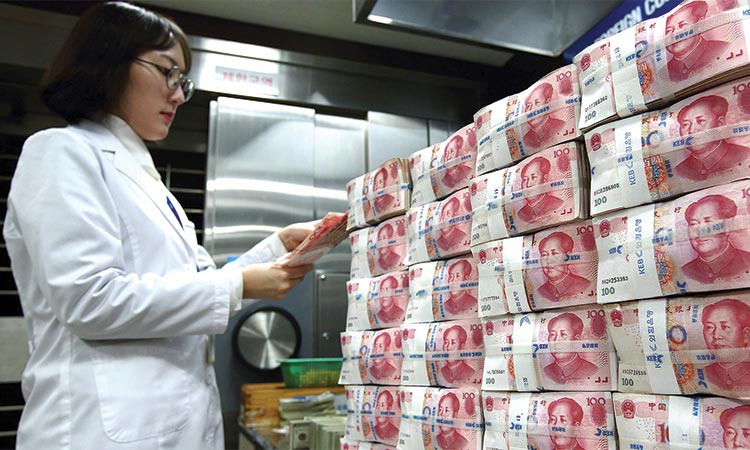Chinese data rekindles woes about health of global economy

An employee working on manufacturing products that will be exported to the US at a factory in Binzhou, China, on Friday. Agence France-Presse
Data from Beijing painted a fairly gloomy picture of the world’s second largest economy as the trade war with the United States starts to bite. May industrial output growth slowed to a more than 17-year low, well below expectations, while fixed-asset investment also fell short of forecasts.
Expectations for more stimulus in China are growing as the Sino-US trade dispute threatens to escalate into a full-blown trade war that many fear could push the global economy into recession.
The data saw yields on German 10-year Bunds − seen as one of the safest assets in the world − fall to fresh record lows. US Treasury yields were also grinding lower. Safe-haven bond yields have already fallen in recent days amid rising speculation about monetary easing by major central banks. Spain bond yields have fallen for the first time below 0.5%.
Gold prices hit a 14-month high.
“The Chinese data was disappointing, especially the industrial output numbers,” said Chris Scicluna, head of economic research at Daiwa Capital Markets. “That’s given bond markets additional momentum.” Equity markets across Europe chalked up hefty losses on the risk-off sentiment, with a warning by US chipmaker Broadcom Inc of a slowdown in demand due to trade tensions and the US ban on Chinese tech and mobile phone company Huawei Technologies exacerbating the glum mood.
The pan-European STOXX 600 index fell 0.7% - its biggest daily decline in two weeks. Germany’s trade-sensitive DAX fell 0.9%.
European tech shares led the indexes lower, with semiconductor companies Infineon, AMS, STMicroelectronics, Siltronic and Dialog Semiconductor all dropping between 4%-7% after Broadcom outlined the impact of a total halt in sales to Huawei.
“The sales warning from Broadcom is also weighing on markets this morning as it suggests that both semiconductor and auto sectors are under pressure worldwide,” said Christophe Barraud, chief strategist at brokerage Market Securities in Paris, adding that expectations for a rebound were now shifting from the second half of this year to 2020.
“Given both these sectors are key for world trade, it’s not good news for trade.” US stock futures indicated Wall Street was in line for a lower open, with the S&P e-mini pointing to a 0.3% fall.
Wall Street shares have had a strong run in June on hopes the Federal Reserve will ease monetary policy soon to counter pressure on the US economy from the escalating trade war. The S&P 500 index is up about 5% so far this month.
The Fed’s June 18-19 meeting will give investors an opportunity to see if the US central bank’s monetary policy stance matches market expectations for a near-term rate cut.
A Reuters poll showed a growing number of economists expect the Fed to cut interest rates this year although the majority still expect it to stay on hold.
“There is a large degree of uncertainty going into next week’s FOMC (Federal Reserve Open Committee) meeting as market reaction will differ significantly depending on whether the Fed hints toward easing policy,” said Shusuke Yamada, chief Japan FX and equity strategist at Bank Of America Merrill Lynch.
“A wait-and-see mood is likely to begin prevailing in the markets ahead of the FOMC.” Growing worries about a new U.S.-Iranian confrontation after two attacks on two oil tankers in the Gulf of Oman on Thursday added to the unhappy mood.
Washington blamed Iran, but Tehran bluntly denied the allegation. US and European security officials as well as regional analysts left open the possibility that Iranian proxies, or someone else entirely, might have been responsible.
The attacks set crude prices on a roller coaster ride, with Brent futures gaining 0.2% to $61.42 per barrel. Brent surged 2.2% on Thursday after the Norwegian- and Japanese-owned tankers both experienced explosions.
In currency markets, the dollar’s index against a basket of six major currencies edged higher to 97.133 after ending the previous day nearly flat, with caution ahead of the Fed meeting keeping the greenback in a fairly tight range.
The euro was a touch softer at $1.1261 while the greenback inched down 0.2% to 108.22 yen.
The Australian and New Zealand dollars fell on Friday as bets on interest rate cuts undermined demand and Group of 20 meeting later this month sidelined investors.
Oil prices rose again Friday in reaction to geopolitical tension, building on the previous day’s surge sparked by suspected attacks on two tankers in the Gulf of Oman.
The US government blamed Iran for mysterious explosions on the tankers, and there were growing fears that Iran could close the Strait of Hormuz, a major choke point for world oil shipments.
Agencies







